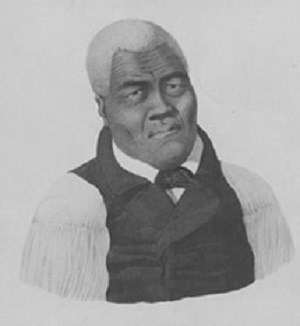Last updated: June 10, 2024
Article
Hawai'i Island: Pu'ukohola Heiau National Historic Site

Courtesy of the National Park Service
At Pu'ukohola Heiau National Historic Site on the Hawai'i Island coast at Kawaihae, influential Hawaiian figures lived and made decisions that changed the course of Hawaiian history and daily life. The park preserves historic structures and sites associated with the Hawaiian people and their leader Kamehameha the Great, the unifier of all the Hawaiian Islands. A stroll through this park vividly brings alive the legends, history, and culture of Hawai'i.
Upon entering the park, visitors first see Pu'ukohola Heiau, the great temple of Kamehameha the Great, one of the last major temples built on the Hawaiian Islands before outside influences altered Hawaiian daily life forever. Constructed under the direction of Kamehameha I between 1790 and 1791, Pu'ukohola Heiau is also known as the Temple on Whale Hill.
Born around 1758 when the appearance of a white-tailed star prompted Hawaiian prophets to predict the coming of a great leader, Kamehameha was the son of a high chief and a princess. He began training at a young age with the na ali'i koa, the chiefly warriors. By young adulthood, he was an expert warrior, and by 1782, he inherited land on the northern part of Hawai'i and gained custody of his family's war god, Kuka'ilimoku. With the power he gained, Kamehameha hoped to unite the warring Hawaiian Islands and bring them peace.
In the late 1700’s, many Hawaiians believed that Kamehameha’s destiny was to unite and rule over all the Hawaiian Islands. By 1790, Kamehameha had invaded and conquered Maui, Lana'i, and Moloka'i but had difficulty claiming and conquering his home island of Hawai'i because of the opposition of his chief rival and cousin, Keoua Kuahu'ula. For guidance, Kamehameha sent his aunt to the prophet Kapoukahi. The prophet stated that Kamehameha would unite and rule the islands if he built a large heiau (temple) to his family war god Kuka'ilimoki atop Pu'ukohola (Whale Hill).
Kamehameha immediately organized the construction of this great heiau, which is still visible today at the Pu'ukohola Heiau National Historic Site. The task was so large that Kamehameha called in thousands of men to build the heiau. Even chiefs and Kamehameha helped with the labor. The prophet prescribed the use of special water-worn lava rocks to construct the temple, one of the many rigid guidelines that needed to be followed to please the war god, Kuka'ilimoki. To accomplish this task and to obtain the proper materials, laborers formed a human chain 20 miles long to the seaside valley of Pololu.
By the summer of 1791 the heiau, standing 224 by 100 feet with 16 to 20 foot high walls without any mortar, was complete. Kamehameha invited his rival cousin, Keoua Kuahu'ula, to the dedication ceremony. At the ceremony, an unintended fight occurred that left Keoua and many of his companions dead. The body of Keoua was carried to the top of Pu'ukohola Heiau and offered as the principal sacrifice to Kuka'ilimoki. This event ended all opposition to Kamehameha on his home island of Hawai'i, and much of the prophecy began to come true.
By 1810, Kamehameha the Great successfully united the Hawaiian Islands. He succeeded through military conquests, by following the advice of his trusted military advisors John Young (British) and Issac Davis (Welsh), by using new technologies, negotiating treaties, and adhering to his deeply rooted spiritual beliefs. The Pu'ukohola Heiau stands as a testament to this Hawaiian leader and this important period in Hawaiian history.
Mailekini Heiau, another temple in the park, predates Pu'ukohola Heiau. Its original purpose is uncertain. During Kamehameha’s rule, Mailekini Heiau served as a fort. Around 1812, John Young, one of Kamehameha’s trusted military advisors, advised him to mount cannons on the heiau to help protect Kamehameha and Pu'ukohola Heiau.
The remains of John Young's home, possibly the first Western-style structure built in Hawai'i, are slightly northwest of Pu'ukohola Heiau. The home was constructed using a combination of Western and Hawaiian techniques. The mixing of cultural styles, beliefs, and building techniques rapidly became more commonplace during this time.
In 1819, King Kamehameha passed away and his son Liholiho began his ascension to the throne as King Kamehameha II. To prepare himself to take his father’s place, Liholiho went to Pelekane (The Royal Courtyard), near the ocean and only a short walking distance from Pu'ukohola Heiau. Soon after coming to power, Liholiho (Kamehameha II) ended the kapu (taboo) system. Hawaiians used the kapu system, which was based on religious and practical beliefs, to maintain law and order for centuries. The termination of the kapu system forever changed the purpose of Pu'ukohola Heiau leading to the abandoning of the heiau shortly thereafter. Pu'ukohola Heiau's role in the unification of the Hawaiian Islands by Kamehameha the Great is significant for understanding Hawaiian cultural heritage and history.
Visitors can experience the sites, sounds, history, and mana (spiritual power) of Pu'ukohola Heiau, Mailekini Heiau, Pelekane, John Young’s Homestead, and other sites associated with the Hawaiian people by taking a self-guided one-hour walking tour at Pu'ukohola Heiau National Historic Site.
Pu'ukohola Heiau National Historic Site, a unit of the National Park System, is located at Kawaihae Road in Kawaihae, HI. Pu'ukohola Heiau National Historic Site is open daily from 7:45am to 5:00pm (including Federal holidays). There is no admission fee. For more information, visit the National Park Service Pu'ukohola Heiau National Historic Site website or call 808-882-7218.
